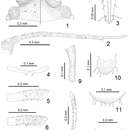Description
(
englanti
)
tarjonnut Zookeys
Apterous viviparous females: Body oval, 1.42–1.62 mm long, 0.82–0.95 mm wide. Green in life. In mounted specimens, body pale; apical parts of base of antennal segment VI and processus terminalis, apex of rostrum and tarsi brown, other parts pale (Fig. 13).
Head: Head scabrous, with dense spinules or warts on dorsum and venter, but warts on dorsal median area of head are sparse (Figs 1, 14). Dorsal setae of head very short, blunt or slightly expanded at apex. Head with one pair of frontal setae and two pairs on antennal tubercles, two pairs of dorsal setae between antennae, two pairs of dorsal setae between eyes. Frontal setae approximately as long as dorsal setae of head, 0.005–0.012 mm, 0.2–0.5 of basal diameter of antennal segment III. Antennal tubercles well developed, very broad, converging, with dense warts; medial frontal tubercle indistinct (Figs 1, 14). Antennae 6-segmented, segments I-V and base of segment VI with distinct warty imbrications (Figs 2, 15), processus terminalis with weak imbrications (Fig. 16), segment III slightly constricted at base (Figs 2, 15); antenna 0.87–0.88 mm long, 0.54–0.61 times length of body; segment III 0.26–0.27 mm, lengths of segments I-VI: 27-31, 19-22, 100, 46-47, 42-46, 32-38+52-61, respectively; processus terminalis 1.60–1.77 times base of segment. Antennal setae short and blunt, segments I-VI each with 3, 1, 6-7, 4, 4, 2+3 setae, respectively, apex of processus terminalis with three short setae; length of setae on segment III 0.005–0.007 mm, 0.22–0.30 times as long as basal diameter of the segment. Primary rhinaria not ciliated, secondary rhinaria absent (Fig. 2). Rostrum (Figs 3, 18) reaching between mid- and hind coxae, ultimate rostral segment wedge-shaped, 0.11–0.12 mm long, 2.15–2.53 times as long as its basal width, 1.30–1.44 times as long as second hind tarsal segment, with three pairs of primary setae and two or three accessory setae.
Thorax: Dorsum of thorax with wrinkles, more distinct toward marginal area of body; pronotum with one pair of spinal and one pair pleural setae, respectively, marginal setae indistinct; metanotum with one pair of spinal, two pairs of pleural and one pair of marginal setae, respectively. Mesosternal furca with a short stem (Figs 4, 17). Spiracles small, reniform-shaped, closed; distance between 6th and 7th spiracles much less than that between 5th and 6th. Legs: distal 2/3–4/5 part of femora with distinct warty imbrications (Figs 5–7, 21–23), outer of basal part of tibia with warts (Figs 8, 24), others smooth. Hind femur 0.35–0.38 mm long, 1.28–1.46 times antennal segment III; hind tibia 0.55–0.61 mm long, 0.35–0.42 times length of body; setae on hind tibia long, thick and pointed, 0.025–0.030 mm long, 0.77–1.00 times as long as middle width of the segment. First tarsal chaetotaxy: 3, 3, 3. Second hind tarsal segment 0.08 mm long.
Abdomen: Abdominal tergites I-VI with wrinkles, more distinct toward marginal area of body (Fig. 19); posterior area of siphunculi with distinct spinules, tergites VII-VIII with sparsely spinulose transverse stripes; venter with spinulose transverse stripes. Dorsal setae of body very short, blunt or slightly capitate at apex, ventral setae short and acute. Abdominal tergites I-VII each with one pair of spinal setae, tergites I, V-VII each with one pair of marginal setae, tergites II-III each with two pairs of marginal setae, tergite IV with three pairs of marginal setae; tergite VIII with two dorsal setae. Length of marginal setae on tergite I about as long as dorsal setae on tergite VIII, 0.005 mm, 0.2 of basal diameter of antennal segment III. Siphunculi cylindrical (Figs 9, 20), constricted in middle, inner side of distal half slightly elongated; with dense imbrications, flangeless, ends of siphunculi truncated, with pore in central area; 0.20–0.21 mm long, 0.13–0.14 times as long as body, 3.42–4.32 times as long as its basal width, 2.2–2.3 times cauda. Cauda tongue-shaped, blunt at apex (Figs 10, 25), 0.09–0.094 mm long, 0.075–0.088 mm wide, with 4–5 setae. Anal plate semi-circular (Fig. 11), with 10 setae. Genital plate broadly circular (Figs 12, 26), with 10–14 posterior setae and two anterior setae.
Hind tibiae in immatures (third instar) without spinules, smooth (Fig. 27).
- lisenssi
- cc-by-3.0
- tekijänoikeus
- Xing-Yi Li, Bin Zhang, Xiao-Mei Su, Ge-Xia Qiao
- bibliografinen lainaus
- Li X, Zhang B, Su X, Qiao G (2013) First record of the aphid genus Jacksonia Theobald (Hemiptera, Aphididae, Aphidinae) from China, with description of one new species ZooKeys 312: 79–87
- tekijä
- Xing-Yi Li
- tekijä
- Bin Zhang
- tekijä
- Xiao-Mei Su
- tekijä
- Ge-Xia Qiao

